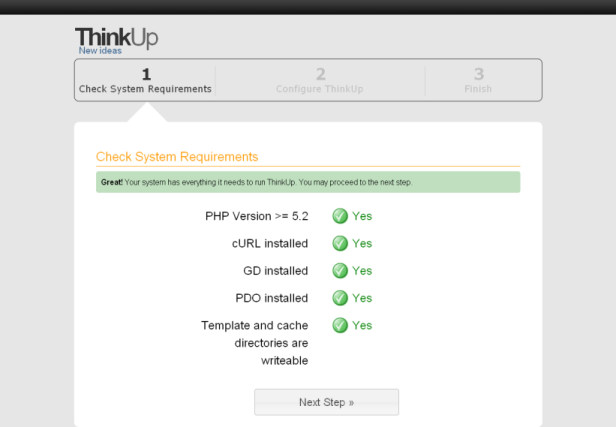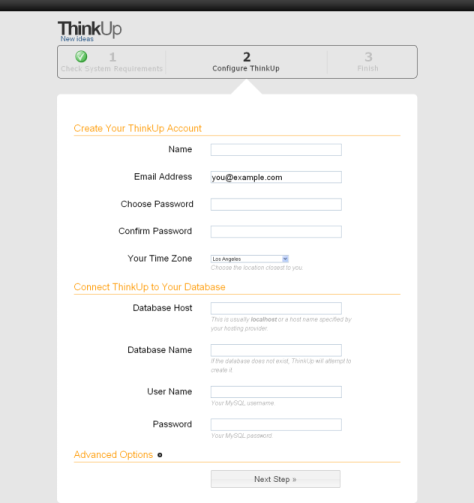Difference between revisions of "ThinkUp"
Kate Lomax (talk | contribs) m |
Kate Lomax (talk | contribs) m (slight reordering of the steps) |
||
| (7 intermediate revisions by the same user not shown) | |||
| Line 8: | Line 8: | ||
You can download ThinkUp from the [http://github.com/ginatrapani/thinkup/downloads download page] and unpack the file in your web directory (and for those with development chops, a git version is available). | You can download ThinkUp from the [http://github.com/ginatrapani/thinkup/downloads download page] and unpack the file in your web directory (and for those with development chops, a git version is available). | ||
<pre>wget | <pre>wget https://github.com/downloads/ginatrapani/ThinkUp/thinkup_0.12.1.zip | ||
unzip thinkup_0.12.1.zip</pre> | |||
You will also need to ensure you have write permission to certain directories. Just navigate to the web installer and it will tell you which ones. If you’ve saved it in your web directory under the name ‘thinkup’, you can access the installer at:<br><br>e.g. http://bubba.local/thinkup/install | You will also need to ensure you have write permission to certain directories. Just navigate to the web installer and it will tell you which ones. If you’ve saved it in your web directory under the name ‘thinkup’, you can access the installer at:<br><br>e.g. http://bubba.local/thinkup/install | ||
This will flag any problems or missing requirements. For example, the compiled view directory needs to be given write access: | This will flag any problems or missing requirements. For example, the compiled view directory needs to be given write access: | ||
<pre>chown -R www-data /home/web/thinkup/_lib/view/compiled_view/</pre> | <pre>chown -R www-data /home/web/thinkup/_lib/view/compiled_view/</pre> | ||
The requirements for ThinkMap also includes the cURL php library, which is not enabled on bubba servers out of the box. | The requirements for ThinkMap also includes the cURL php library, which is not enabled on bubba servers out of the box. | ||
== Installing cURL == | == Installing cURL == | ||
You can install cURL using apt-get: | You can install cURL using apt-get: | ||
<pre>apt-get install php5-curl | <pre>apt-get install php5-curl</pre> | ||
Open the php.ini file using whatever text editor you have: | Open the php.ini file using whatever text editor you have: | ||
<pre>nano /etc/php5/apache2/php.ini | <pre>nano /etc/php5/apache2/php.ini | ||
vi /etc/php5/apache2/php.ini</pre> | vi /etc/php5/apache2/php.ini</pre> | ||
You then need to add the following line to your php.ini file, under extensions : | You then need to add the following line to your php.ini file, under extensions (which is towards the bottom of the file, so keep scrolling): | ||
<pre>extension=php_curl.so | <pre>extension=php_curl.so | ||
</pre> | </pre> | ||
Because of the way PHP is setup on Bubba, you also need to create a symbol link: (solution hat tip: [http://forum.excito.net/viewtopic.php?f=9&t=1854&p=8626&hilit=php5#p8626 on the forums]): | |||
<pre>ln –s /etc/php5/conf.d/curl.ini /etc/php5/apache2/conf.d/curl.ini</pre> | <pre>ln –s /etc/php5/conf.d/curl.ini /etc/php5/apache2/conf.d/curl.ini</pre> | ||
<br> Now, return to the browser and reload the webinstaller. If all is well, it's time for configuration. | |||
any changes to the php settings will require a server restart: | |||
<pre>/etc/init.d/apache2 restart</pre> | |||
<br><br> Now, return to the browser and reload the webinstaller. If all is well, it's time for configuration. | |||
[[Image:Installer-aok.png|center|the ThinkUp web installer - ready for configuration]]<br> | [[Image:Installer-aok.png|center|the ThinkUp web installer - ready for configuration]]<br> | ||
<br> | <br> | ||
== Configuring ThinkUp == | == Configuring ThinkUp == | ||
| Line 62: | Line 64: | ||
== Start analysing == | == Start analysing == | ||
To download data, you can run the crawler from dashboard | To download data, you can run the crawler from dashboard by clicking 'Update'. This can take a bit of time. You can automate these crawls by subscribing to the RSS feed provided during the update or creating a cron job with the log information shown. | ||
Once plugins have been configured and data downloaded, you're all set to start archiving, charting, visualising, mapping and otherwise analysing your social media communication. | Once plugins have been configured and data downloaded, you're all set to start archiving, charting, visualising, mapping and otherwise analysing your social media communication. | ||
Latest revision as of 19:08, 25 May 2011
Archiving social media data with ThinkUp
Bubba servers are a great for backing up (and analysing) data from web applications and social networks. There are a few different tools available to do this, but for its ease of installation and flexibility, I've been using ThinkUp.
ThinkUp is a new(ish) open source tool for storing, analysing and visualising social media data, such as Twitter and Facebook communication. It has a web installer and instructions available, but there are a couple of extra steps to get it up and running on Bubba.
Download ThinkUp
You can download ThinkUp from the download page and unpack the file in your web directory (and for those with development chops, a git version is available).
wget https://github.com/downloads/ginatrapani/ThinkUp/thinkup_0.12.1.zip unzip thinkup_0.12.1.zip
You will also need to ensure you have write permission to certain directories. Just navigate to the web installer and it will tell you which ones. If you’ve saved it in your web directory under the name ‘thinkup’, you can access the installer at:
e.g. http://bubba.local/thinkup/install
This will flag any problems or missing requirements. For example, the compiled view directory needs to be given write access:
chown -R www-data /home/web/thinkup/_lib/view/compiled_view/
The requirements for ThinkMap also includes the cURL php library, which is not enabled on bubba servers out of the box.
Installing cURL
You can install cURL using apt-get:
apt-get install php5-curl
Open the php.ini file using whatever text editor you have:
nano /etc/php5/apache2/php.ini vi /etc/php5/apache2/php.ini
You then need to add the following line to your php.ini file, under extensions (which is towards the bottom of the file, so keep scrolling):
extension=php_curl.so
Because of the way PHP is setup on Bubba, you also need to create a symbol link: (solution hat tip: on the forums):
ln –s /etc/php5/conf.d/curl.ini /etc/php5/apache2/conf.d/curl.ini
any changes to the php settings will require a server restart:
/etc/init.d/apache2 restart
Now, return to the browser and reload the webinstaller. If all is well, it's time for configuration.
Configuring ThinkUp
The next step is to complete the host and database details but, again, the installer should walk you through these steps. If you have set the right permissions, it will even create the database for you.
Help I didn't get the mail!
Now, you will be prompted to set up an adminstrator account and an email address for the activation email to be sent to. You won't be able to login with just the account details, the account needs to be activated first. If you don’t have mail set up (and the installer directs you to PHP mail), there is a workaround to activating the user account. You need to access the owners table (tu_owners) and change the field is_activated to 1 in your database manually. This will activate your account and allow you to login.
log in.
Enable plugins
ThinkUp comes with some default plugins already installed for Twitter, Facebook and Flickr. You can configure these to work with your social media accounts by clicking on the icon for each plugin and following the instructions.
For Twitter, you need to register your ThinkUp app with Twitter and generate the consumer key and secret. Set the application Default Access type to "Read-only". You can then add the details from Twitter to the plugin in ThinkUp.
Start analysing
To download data, you can run the crawler from dashboard by clicking 'Update'. This can take a bit of time. You can automate these crawls by subscribing to the RSS feed provided during the update or creating a cron job with the log information shown.
Once plugins have been configured and data downloaded, you're all set to start archiving, charting, visualising, mapping and otherwise analysing your social media communication.

